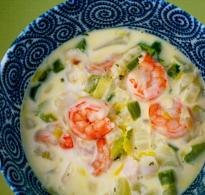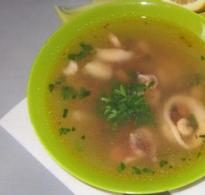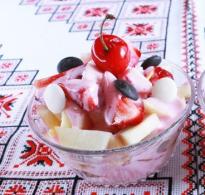White unfiltered beer brand. Unfiltered beer
Until now, wheat beer, invented by the Bavarian Germans, was considered an exotic product in Russia. The types of beer familiar to the Russian people are prepared by bottom fermentation, while the technology for making wheat unfiltered white beer involves the process of top fermentation. During the preparation of white beer and ale, the yeast rises to the surface of the fermentation tank. The wort of this beer contains about 50-70% wheat. Today, experts distinguish four main types of wheat beer: Berlin, South German, Belgian and American.
Wheat white beer unfiltered, supplied in kegs, is distinguished by a characteristic sourness. Its bitterness, in comparison with other varieties, is minimal. Referred to as white, real live beer in the world has a lot of variations. Each brewing company tries to create its own special recipe for this drink, which is famous for its unique aroma. The richest bouquet, a variety of shades and tastes, thick strong foam - all this makes wheat unfiltered white beer a favorite drink of true connoisseurs.
Wheat unfiltered white beer will ideally quench your thirst in the summer heat. Its temperature during serving is no more than 9-10 ˚С, and for filtered it is even less - 7-8 ˚С. Many people prefer to add a slice of lemon to the glass, but the German brewing industry categorically does not recommend doing this. Lemon not only distorts the taste of the drink itself, but also adversely affects the foam, which, under the action of the essential oils contained in the peel of the fruit, instantly falls off.
To feel the fullness of the taste of this variety, beer should be consumed from special very tall glasses of an elongated shape. Unfiltered beer drinkers often don't rinse out leftover yeast that accumulates on the walls of the dishes, because they believe that they can exacerbate the specific taste and aroma of the next serving.
Despite the fact that brewing traditions in Russia are not as long as in Germany, nevertheless, our brewers managed to successfully master the technique of making wheat unfiltered white beer. Baltika No. 8, which appeared on our market about ten years ago, gained particular popularity in professional circles. KEGGER"S offers you unfiltered white wheat beer in kegs of 30 liters: Baltika No. 8, Holsten Weiss, Kronenbourg 1664 Blanc, Edelweiss Weissbier, etc.
Unfortunately, the shelf life of unpasteurized beer is short. Of course, this does not apply to a bottled product saturated with preservatives, which can hardly be called a beer. Today, beer lovers increasingly prefer draft beer, which is distinguished by a rich and bright taste. Such a product contains vitamins and beneficial microflora, which disappear during the pasteurization process. Live wheat beer has a rich bready aroma and a rich bouquet of flavors.
Hermetic closure in kegs allows you to extend the shelf life of draft beer up to 1 month. Moreover, beer is not only stored in a keg until it is sent to the consumer, but also matures! The fermentation of the residual extract, as this process is scientifically called, contributes to the saturation of the beer with carbon dioxide. The taste and aroma of the drink becomes complete, full, saturated.
Ordered in KEGGER"S unfiltered white wheat beer will allow you to feel all the nuances of the taste of a true intoxicating drink!
Unfiltered (“live”) beer is loved by gourmets around the world. Connoisseurs say that this drink has a lot of useful properties and is almost completely devoid of the disadvantages of ordinary pasteurized beer: an indistinct average taste without a “zest”, a weak aroma and an almost complete lack of vitamins.
Short story. In fact, we should rather talk about the history of filtered beer - in the old days, all ales were unfiltered, since the technologies for filtration, separation and pasteurization, which will be discussed later, simply did not exist. The modern fashion for live beer is just a return to the roots.
The type of fermentation is very important. In the production of a foamy drink, two types of yeast are used: "top" and "bottom". The latter love the cold and die at room temperature, but the former feel great even at 20-25 degrees Celsius, so traditionally real unfiltered beer is obtained from top-fermenting yeast (called “ale”). Before the invention of the refrigerator, it was very difficult to constantly maintain a temperature of 7-10 ° C that was comfortable for bottom-fermenting yeast, usually such beer (“lager”) was brewed only in winter. At the moment, the share of lager in the world market is about 95%.
Benefits of unfiltered beer The drink contains amino acids, B vitamins, enzymes, magnesium, calcium and other useful substances. In moderation, this beer is recommended for people with impaired metabolism, poor appetite, digestive system disorders, weak bones and joints. Unfiltered and pasteurized beer has a beneficial effect on the kidneys, heart and nervous system.
Features of the production of unfiltered beer
Unfiltered beer is made in exactly the same way as any other: from malted grains, yeast, hops, water and flavorings (depending on the recipe). The only difference in technology is that the drink is not subjected to thorough filtration and pasteurization, which “kill” and remove yeast, so the fermentation process does not stop even in bottles, and unfiltered beer can be stored for no more than two weeks.
The most “live” beer, which has not even gone through basic filtration, can only be tasted at the factory, it is not available for sale. It turns out a rather specific drink with a distinct yeasty taste, which is not commercially successful, so in most cases even unfiltered beer goes through the clarification process (by separation or light filtration).
Separation looks like this: the processed raw material (in our case, beer) is poured into a centrifuge and accelerated to a speed of several thousand revolutions per minute. Under the influence of centrifugal force, all large and solid particles remain on the walls, and the liquid itself is slightly cleaned. The effect of this process is about the same as that of pre-filtering.
Sometimes on the shelves of shops come across unfiltered, but pasteurized varieties. Beer sommeliers claim that these drinks are completely devoid of all useful properties, and therefore cannot be called real live beer. The same reputation goes for beer with preservatives, which remains fresh even after 20-30 days, but the taste is hopelessly spoiled.
Why is beer filtered? A natural question arises: if unfiltered beer is so great, why is filtering necessary? It's simple - to increase the shelf life. When produced in industrial volumes, products are not sold out on the very first day: bottles, cans and barrels (kegs) lie in the warehouse for a couple of days, then they are transported to retail outlets throughout the country and exported abroad. At the same time, the beer should remain as fresh as on the day of bottling, and if the container has been fermenting all this time, the buyer will receive sour mash, and not an invigorating and healthy drink.
The difference between filtered and unfiltered beer
| filtered | Unfiltered |
| Keeps for several months. | Stored 5-10 days. |
| Can be poured into transparent bottles, stored in the light. | It deteriorates from sunlight, it is better to produce in dark glass bottles or cans, store in a dark place. |
| No yeast sediment. | There is yeast sediment. |
| It goes through several stages of purification, the filters trap even the smallest organic particles. | It passes only one filtration, the equipment retains only the largest fractions of fermentation products. |
| It has a less pronounced taste, color and aroma. | It has a rich taste, color and aroma. |
| Contains a small amount of vitamins and amino acids. | The content of nutrients is 10 times higher than in filtered beer. |
| Transparent, no sediment. | Cloudy, visible to the naked eye. |
| Less calories. | More calories. |
 Left - filtered, right - unfiltered
Left - filtered, right - unfiltered Types and manufacturers
Wheat unfiltered beer is especially popular - soft enough to smooth out the harsh taste of yeast sediment, has a pleasant taste and aroma. Some doctors and sports trainers even recommend drinking this drink after intense workouts to replenish fluid loss and quickly restore strength due to the carbohydrates contained in beer.
Wheat beer appeared no later than two thousand years ago (and most likely earlier), but has always been inferior in popularity to its dark barley counterpart. Firstly, because of the low strength, and secondly, in the famine years it was a pity to transfer good white grain to alcohol instead of bread. The "father" of wheat brewing is Baron Hans Degenberg, who in the middle of the 16th century was the first to receive a patent for the exclusive right to produce this particular light variety.
 Wheat unfiltered beer is always white, other varieties can be any color
Wheat unfiltered beer is always white, other varieties can be any color In the production of unfiltered wheat beer, German, Belgian and Dutch brewers have achieved particular success. The best brands are Erdinger, Franziskaner, Paulaner, Hoegaarden. Some of these producers use special author's technologies - for example, they add an additional portion of yeast to already bottled beer in order to obtain the so-called two-stage fermentation. Another technique involves brewing beer from unsprouted wheat, while the proportion of additives (barley and oats) can reach 55% or even more.
In Russia, the term "unfiltered" can be found on the products of many manufacturers, from Baltika to Ochakovo, but these brands can hardly be considered worthy representatives of the "live" class. If you want to definitely try domestic examples, it is better to find a home brewery or craft production - we recall that unfiltered beer is practically not produced on an industrial scale, because it has a short shelf life.
How to drink unfiltered beer
Unfiltered beer is poured into tall transparent glasses, trying not to provoke too active foaming. At the same time, the yeast sediment is not poured out, but on the contrary, it is carefully added to the glass - the taste is not the same without it. Serving temperature - 5-12 ° C (it is recommended to follow the manufacturer's recommendations).
 The best snack for unfiltered beer
The best snack for unfiltered beer Gourmets say that light unfiltered varieties have subtle notes of lime, citrus, even blackcurrant and freshly cut grass, so lighter snacks are required for it - for example, cold cuts, croutons with cheese.
White beer, whose name in German sounds like "weissbier", has long been part of our lives, although many argue that this beer is completely new. Do not be afraid of the name and think that the color of this drink is really white. This is a regular golden unfiltered wheat beer. Sometimes various concentrates, herbs or spices are added to it to give it a more interesting taste. Some varieties, for example, are boiled with orange peel, cinnamon, coriander, etc.
Story
The history of white beer goes back over four hundred years. Previously, almost all beer was dark, since it was produced using partially or fully roasted malted barley. In those days, it was almost impossible to get light malt, but when brewers created a light drink, they called it weiss beer - “white beer”. This emphasized its difference from the usual dark. At the same time, it did not matter what basis the white beer had (wheat or barley), and also by what technology it was brewed.
Composition of white beer
The composition of white beer includes malted barley or wheat, yeast, as well as a variety of additives that make the taste of this drink especially rich. Since ancient times, the recipe has not changed much, except that brewers began to add hops to this drink and use modern technologies. Due to the addition of wheat and herbs, as well as the absence of a filtration process in the recipe, white beer has a distinctive feature - a large amount of sediment. This type of beer is drunk along with the sediment, because it is in it that the whole taste of this drink is concentrated - rich, with a slight sourness. Of course, if you wish, you can drink white beer without sediment, but in this case you risk missing your chance to enjoy its unique taste, which is so appreciated by beer lovers around the world. For more information about white beer and other types of this intoxicating drink, you can visit
Brands and varieties of unfiltered beer, which is currently offered in stores, are not particularly numerous. Although it has ceased to be a rarity in retail chains, it does not have such a large assortment as ordinary light or dark beer. Despite the fact that "Chernihiv White Unfiltered" appeared in stores a long time ago, in my opinion, this beer is the best in its category. I specify, among those brands that are offered in the distribution network and are produced in large quantities.
Over the past couple of months, I have had the opportunity to try three brands of store-bought unfiltered beer - Chernihivske Belye, by far, the best among them. My first acquaintance with this beer took place in 2009, I still remember the splashed walls in the office - they wanted to use the instructions on the label, they shook it so that when they opened the bottle they got a foamy show. Therefore, I draw attention to caution when pouring after stirring the rest of the beer to raise the yeast sediment or simply shake it. As for other consumer properties of beer "Chernigov white unfiltered". Container - glass bottle 0.5 l and plastic - 1 l.

Alcohol content - 4.8%, density - 12%. Color - golden, opaque, characteristic of unfiltered light beer. The aroma is bright and long, the presence of coriander is felt, which is indicated in the composition of the beer. In my opinion, too rich smell for beer. The taste matches the aroma. There is a good sense of wheat and spicy flavor, and a fruity tinge. We can say that the beer has an original bouquet, which does not spoil it. Delicious and well balanced. Very good bitter aftertaste. In general, the composition of the beer "Chernihiv White Unfiltered" is selected for independent consumption of the drink. Of course, it is also suitable for dried fish or seafood. However, both the aroma and taste of Chernihiv White Unfiltered beer are so bright that the greatest pleasure is achieved when drinking the drink without any snacks. Naturally chilled. By the way, the recommendations indicate that this beer should be drunk in large sips - generally correct, but small ones are also very good.

It doesn't happen, of course, that everything goes well. So in the beer "Chernihiv White Unfiltered" there are drawbacks. Many believe that if the beer is unfiltered, then it is alive and does not have any special impurities. Alas, the shelf life of this beer is 90 days, which means the presence of certain chemical additives. When studying the composition of beer, you can see substances, for example, apple pectin, from where the fruity aroma and smell come from.

Real live beer is another product. For example, beer, which is produced in the Orlinovskaya brewery, near Sevastopol.
My review of "live" beer from Orlinoe
In general, as an unfiltered beer produced on an industrial scale, Chernihiv White Unfiltered deserves a solid four.






